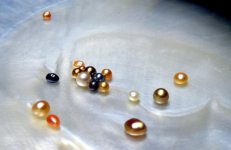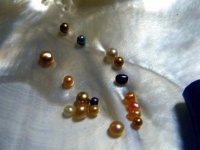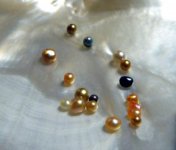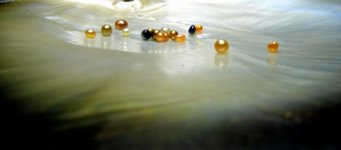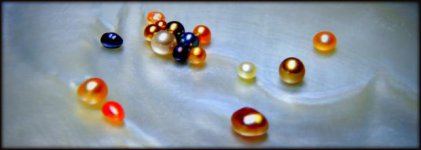You are using an out of date browser. It may not display this or other websites correctly.
You should upgrade or use an alternative browser.
You should upgrade or use an alternative browser.
Pinctada Maculata (Pipi) Pearls
- Thread starter SteveM
- Start date
Babypearl
New Member
Hello Loloperle,
Gorgeous pearls you have and what amazing colours. You are very very lucky!
Babypearl
Gorgeous pearls you have and what amazing colours. You are very very lucky!
Babypearl
Cyril Roger Brossard
Well-known member
- Joined
- Aug 30, 2012
- Messages
- 408
Hello Ramona not all natural no culture
Hi, just being curious, how do you harvest the pearls? is the Oyster condemned in the process or is the pearl removed by a tech?
Natural Pearls
Natural Pearls
https://www.facebook.com/tahitianpearls?ref=tn_tnmn
Natural Pearls
Hi, just being curious, how do you harvest the pearls? is the Oyster condemned in the process or is the pearl removed by a tech?
https://www.facebook.com/tahitianpearls?ref=tn_tnmn
Natural pearls
Natural pearls
Not intervention of man, I just dive in the sea and I am looking for pearls 100% natural adventure, hard work, but great fun
Natural pearls
Hi, just being curious, how do you harvest the pearls? is the Oyster condemned in the process or is the pearl removed by a tech?
Not intervention of man, I just dive in the sea and I am looking for pearls 100% natural adventure, hard work, but great fun
Cyril Roger Brossard
Well-known member
- Joined
- Aug 30, 2012
- Messages
- 408
Bravo... But you are looking for pearls on the sea bed or for shells with potential pearls.Not intervention of man, I just dive in the sea and I am looking for pearls 100% natural adventure, hard work, but great fun
Very interesting!
Natural pearls
Natural pearls
I work one to four meters deep in the lagoons and pick up shells that can make the pearl, sometimes bags of 80 kilos for 2 or 3 pearl not always marketable, sometimes more, and sometimes nothing .. it is difficult but the moment I opened the shell is very exciting as it is a child who opens his Christmas presents , and it gives me the courage to continue, I normally pinctada harvest gives white pearls , golden yellow, but after 4 years of research I have the chance to know places where it gives different colors as the picture and it is really fantastic
, and it gives me the courage to continue, I normally pinctada harvest gives white pearls , golden yellow, but after 4 years of research I have the chance to know places where it gives different colors as the picture and it is really fantastic 
(I'm sorry I do not speak English very well)
Natural pearls
Bravo... But you are looking for pearls on the sea bed or for shells with potential pearls.
Very interesting!
I work one to four meters deep in the lagoons and pick up shells that can make the pearl, sometimes bags of 80 kilos for 2 or 3 pearl not always marketable, sometimes more, and sometimes nothing .. it is difficult but the moment I opened the shell is very exciting as it is a child who opens his Christmas presents
(I'm sorry I do not speak English very well)
Are you not harming the oyster population that way?
Bonjour Ramona ,
no problem for that, there are a fisherman or can I, and reproduce very quickly that its small pinctada a few centimeters, and I change atoll, sometimes there are atoll or you need permission to fish the pearls
Cyril Roger Brossard
Well-known member
- Joined
- Aug 30, 2012
- Messages
- 408
So the population replenish itself quite rapidly, as you would say "taux de renouvellement rapide", I take it that the collect is regulated by local laws and that the natural seabed is therefore protected from overfishing through stringent rules?Bonjour Ramona ,
no problem for that, there are a fisherman or can I, and reproduce very quickly that its small pinctada a few centimeters, and I change atoll, sometimes there are atoll or you need permission to fish the pearls
I work one to four meters deep in the lagoons and pick up shells that can make the pearl, sometimes bags of 80 kilos for 2 or 3 pearl not always marketable, sometimes more, and sometimes nothing .. it is difficult but the moment I opened the shell is very exciting as it is a child who opens his Christmas presents , and it gives me the courage to continue, I normally pinctada harvest gives white pearls , golden yellow, but after 4 years of research I have the chance to know places where it gives different colors as the picture and it is really fantastic
(I'm sorry I do not speak English very well)
No need to apologize, English isn't the native language of many forum users.
Excuse me but when you open the shell do you cut them open or do you carefully open them as not to damage them? I take it they are killed in the process but as you mentioned earlier the population replenish itself quite rapidly?
Any picture to document this would I think be great in this forum. This is really educational.
Mer?i!
Lagoon Island Pearls
Well-known member
- Joined
- Dec 8, 2009
- Messages
- 2,143
I'd like to see candles of the red and tangerine ones. The blue baroque has an sapphire appearance and the larger round is a royal blue metallic.
The gold pearls are certainly that.
Is this part of a traditional fishery by limited entry? Is there a scientific component? Video, documents etc.
I know nothing of this dive operation, but would gather by the weight of the bags, (80kg) these are likely decadent or over-mature adults. Afterall, the size of a pearl is often directly proportional to the age of the host.
Pearl farms don't target those, thus able to co-exist with local fishers. This is a terrific lot pearls and some may fetch a premium, but diving expeditions into the atolls cannot be an inexpensive or uneventful undertaking.
The gold pearls are certainly that.
Is this part of a traditional fishery by limited entry? Is there a scientific component? Video, documents etc.
I know nothing of this dive operation, but would gather by the weight of the bags, (80kg) these are likely decadent or over-mature adults. Afterall, the size of a pearl is often directly proportional to the age of the host.
Pearl farms don't target those, thus able to co-exist with local fishers. This is a terrific lot pearls and some may fetch a premium, but diving expeditions into the atolls cannot be an inexpensive or uneventful undertaking.
Great to know. Do these oyster grow faster than other oysters? Their colors sure look intriguing.
oysters are very small, but not young, I'll try to put a photo here despite my internet horible
So the population replenish itself quite rapidly, as you would say "taux de renouvellement rapide", I take it that the collect is regulated by local laws and that the natural seabed is therefore protected from overfishing through stringent rules?
No need to apologize, English isn't the native language of many forum users.
Excuse me but when you open the shell do you cut them open or do you carefully open them as not to damage them? I take it they are killed in the process but as you mentioned earlier the population replenish itself quite rapidly?
Any picture to document this would I think be great in this forum. This is really educational.
Mer?i!
well sometimes its monitored, sometimes not, but the head will not let you get the oyster as you want there are several steps to go and especially the repect, a true sharing of cultures .. must do indicate the right places you can search for days without finding anything and waste your time ...
So the population replenish itself quite rapidly, as you would say "taux de renouvellement rapide", I take it that the collect is regulated by local laws and that the natural seabed is therefore protected from overfishing through stringent rules?
No need to apologize, English isn't the native language of many forum users.
Excuse me but when you open the shell do you cut them open or do you carefully open them as not to damage them? I take it they are killed in the process but as you mentioned earlier the population replenish itself quite rapidly?
Any picture to document this would I think be great in this forum. This is really educational.
Mer?i!
yes they are often killed in the process, but do not pick up the small cut, sometimes dive I can see when the oyster is opened but this is rare it shines under the sea is amazing! she smothered sometimes large Pinctada is a problem for farmers, me personally or I it n 'there no big oyster beaucoup glue it on the dead clam, coral, sand, wood
I'd like to see candles of the red and tangerine ones. The blue baroque has an sapphire appearance and the larger round is a royal blue metallic.
The gold pearls are certainly that.
Is this part of a traditional fishery by limited entry? Is there a scientific component? Video, documents etc.
I know nothing of this dive operation, but would gather by the weight of the bags, (80kg) these are likely decadent or over-mature adults. Afterall, the size of a pearl is often directly proportional to the age of the host.
Pearl farms don't target those, thus able to co-exist with local fishers. This is a terrific lot pearls and some may fetch a premium, but diving expeditions into the atolls cannot be an inexpensive or uneventful undertaking.
hello Dave,
yes it is a general traditional fishing has limited access
Sometimes I go on living without atolls but this is rare and very expensive, there is no video, document, I'm alone and I demand a lot of work just photos, but I will return I prepared everything it
yes I do not pick up the young oyster or coral that are sticking to it are often the clam death
the expedition and dive atoll are very expensive sometimes dangerous, I'll try to send a maximum of picture, I am happy to discuss with people with whom I can share my pasion here
thank you this is also true of the pearl are very nice, I have rarely seen such a pearl luster, I'd never even ... this is a great success I find a good buyer hope to continue my research and my pasion
Lolo
Similar threads
- Replies
- 0
- Views
- 11K
- Replies
- 70
- Views
- 22K


